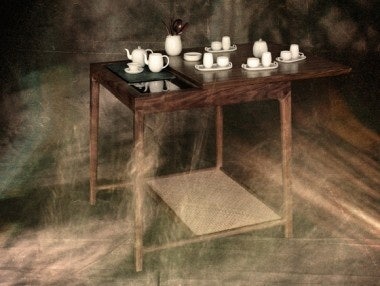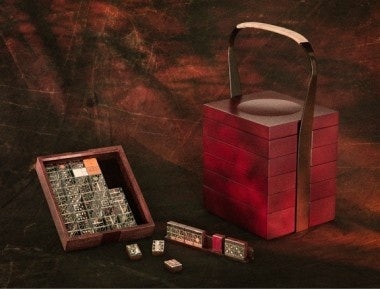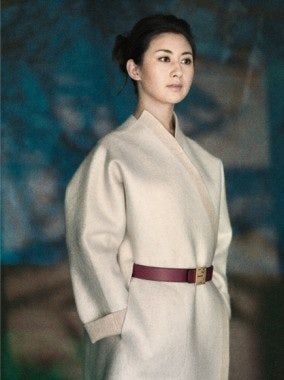"What Is Luxury, In Essence? Time And Emotion"#

Jiang Qiong'er (Image: Shang Xia)
Since its launch last year, Jing Daily has closely followed Shang Xia (上下), the Shanghai-based high-end brand cultivated by the French luxury house Hermès. Situated at Hong Kong Plaza on Huaihai Road and led by artistic director and CEO, Jiang Qiong'er, Shang Xia is perhaps the only premium brand from mainland China that turns to age-old techniques and traditional and rare materials to create contemporary jewelry, apparel, porcelain and home decorations collections.
Recently, as Shang Xia prepared for the launch of its new "Human and Nature" collection and the debut of its exhibition at Sinan Mansions -- for which the brand has outfitted a villa with bamboo, incense and pebbles to showcase a new series of photographs by Paolo Roversi (running through October 12) -- Jing Daily editor Avery Booker sat down for a two-part interview with Jiang Qiong'er about Shang Xia's first anniversary, the burgeoning appreciation for Chinese design now spreading among more sophisticated urban Chinese, and her plans for brand expansion.
Jing Daily (JD): You’re getting ready to celebrate Shang Xia’s first anniversary. Can you give a quick overview of the past year?#
Jiang Qiong'er (JQE)#
: We opened on the 16th of September last year, and have been really happy with the feedback we’ve gotten since then. What we really care about isn’t how much we sell, but what kind of reaction we get from Chinese and overseas guests, media, friends and so on. What we’ve heard from Chinese guests has been really touching, because they’ve told us that our products make them proud to be Chinese. This has made a big impression on us. When they see beautiful design and craftsmanship made by Chinese artisans, looking back at Chinese history, using traditional and beautiful materials, they’re really pleased.
From overseas visitors, they’ve been really surprised by Chinese quality and craftsmanship. China’s been so focused on economic development over the past 30 years, we think that China will start to focus on cultural development over the next 30 years. A lot of overseas visitors have given us positive feedback as well, saying that they’ve been impressed by the creativity of our artisans’ designs. Because everything here is contemporary – it’s not a museum.
JD: And in terms of sales?#
JQE#
: In terms of sales, we do quite well. We average about 60 percent to 40 percent, Chinese clients to overseas clients, and Chinese clients are purchasing more high-value items, like the zitan furniture. Since zitan wood is part of Chinese culture, you don’t have to convince them of the story and the history.

Shang Xia's Da Tian Di tea table, from its 2011-2012 "Human and Nature" collection
JD: Because they already know.#
JQE#
: They already know the story, so they’re naturally drawn to it. And though overseas clients may not understand why zitan is important, if you tell them, it’s like a form of cultural communication. After that, they do have a deeper appreciation of it. What’s interesting is that overseas clients tend to be more drawn to the lacquer finishes than Chinese clients. This is normal, because different cultures have different emotional touchstones. The same goes for our jade collections.
The good thing is that most of our clients have a deep cultural background. We’re still a niche brand with one store, so the people who come here tend to be experts in some way. They know culture, history, porcelain, jade, zitan, so we’re happy to see them.
JD: Aside from having a cultural and historical foundation, what else do you notice about your clients?#
JQE#
: They’re opinion-leaders, not followers. They have their own opinions about what they’re looking for, and we like to have this type of person as a friend of Shang Xia. We see our clients as friends, because we see Shang Xia as a platform for communication. We need Chinese people, and even people from overseas, to appreciate this side of Chinese culture, one based on quality and craftsmanship. So even if they aren’t actually buying something here at the store, they’re ambassadors. Because afterwards, they talk with their friends or companies about Shang Xia, and I think Shang Xia even may inspire them to think about their lives and work a little bit differently.
JD: Since you launched, have you noticed more people in Shanghai trying to do similar things in terms of trying to infuse culture and a more artisanal style into their products?#
JQE#
: I think more people in China realize the importance of looking back to our cultural roots, going back and trying to re-evaluate the value of Chinese culture. I’d say it’s still relatively few, but more are looking at the craftsmanship side of things – that’s the angle we start from. I have some friends who are starting to think in this way, who work in industries like computer gaming and television programming. More people here are starting to realize that, in our lives today, we’re dominated by Western lifestyles. But if you look back at the history of the world, you've got both Western and Eastern cultures. At one time, Eastern culture was on the peak, but that flipped. So maybe it’s time to flip it around again in some way.
Different people are looking for different forms of inspiration from Chinese culture, now, for that reason.
JD: As you said, there are people in China who are opinion leaders, but particularly in the luxury business, most people are followers here. How do you reach these luxury “followers” and let them know what you’re doing at Shang Xia?#
JQE#
: I think the most luxurious thing we have at Shang Xia is time. We don’t set out to make a certain amount of money, because if you put priority on Shang Xia making a profit in a 10-year timeline, then after a few years you start to hurry and panic to do it. But if you put it in a 100-year or a 200-year timeline, you’ve got enough time to ensure really healthy development. Because what is luxury, in essence? Time and emotion. Time from the creator, to think, to make, to communicate. And from the clients, they need to take the time to enjoy their purchase. It’s about time. Emotion comes from the cultural inspiration contained in the object, something that really touches you about it. Something poetic. So I think time is the most precious thing in the luxury business. If you look at the old existing luxury brands, in some cases they’ve taken centuries to get where they are today. 100 years ago, we might not have called them a luxury brand. We’d call them a family workshop, an atelier.
If we want to create a high-quality brand today, we can’t push this baby to grow up in two years, five years. In terms of followers, we prefer to take our time to influence them, to talk to them, until one day they really get it. Maybe the parents won’t get it, but their kids can. We have plenty of time. This makes us feel very…Zen. (laughs)

Jun Zi mahjong set, from Shang Xia's 2011-2012 "Human and Nature" collection
JD: There are a handful of Chinese brands, especially in the jade and watch markets, trying to position themselves as luxury brands. Do you think that their biggest problem is that they’re in too much of a hurry? They all seem to want to conquer the market now. Do you see that as a weakness?#
JQE#
: Some Chinese high-end brands have developed quite well. Here at Hong Kong Plaza, we’ve got Shiatzy Chen, who’s been around for more than 15 years. Her main focus is embroidery, fabrics. She took her time, building up from one store in Taiwan to today having a big production center in China. Then there’s her neighbor in the mall, Qeelin, who started seven years ago [in Hong Kong]. They’ve stayed small but create really great interpretations of Chinese elements. They only have 10 stores after seven years, and just release one collection per year. They’ve taken their time as well.
I think the main problem with the brands that try to position themselves as, quote, “luxury brands” is that they’re just pressed for time because Chinese entrepreneurs have the money to invest, but want to see a quick return on their investment. So the brands have no choice but to hurry.
But the second weakness is that you can’t just price something high and call it a luxury product. We see this in the baijiu market. You need to be acknowledged and appreciated within China and internationally. So I think some of these projects lack an international vision, then in terms of creation and conception they don’t have time to adjust and refocus -- they just spread themselves too thin. Also, you can’t just have the appearance of international quality, you need to really offer it.
JD: So do you think it’s always critical for a Chinese high-end brand to have international recognition before Chinese shoppers will accept it?#
JQE#
: Yes. I think you either call it a “local Chinese luxury brand,” or you call it a luxury brand. They are different. I think that the baijiu that’s really expensive in China, some of the very high-quality teas, these are local Chinese luxury brands. And the examples I gave, Shiatzy Chen, Qeelin, or Shang Xia and Yue-Sai, we try to be luxury brands, but inspired by Chinese culture. This is an important distinction.

Felt cashmere robe from Shang Xia's new "Human and Nature" collection
JD: So over the past year, you'd say you've seen a lot of interest in your collections from overseas shoppers?#
JQE#
: We’ve had quite a few people from places like New York come by. Diane von Furstenberg really liked our porcelain collections and textiles. She wanted to immediately buy everything, and I said, “Stop! (laughs) Get a few pieces now, and get a few more pieces next time. Don’t buy the whole store.” (laughs)
JD: I know you’re planning to go to Paris for your next location. Do you think that once you open in Paris, more Chinese luxury “followers” who might be traveling there will gravitate to Shang Xia when they come home?#
JQE#
: It could be. Yeah, it’s definitely possible. And if we open in Paris, it won’t only be for the sake of image. Our collections have a strong client base from Western countries. This has been tested out in this location. Because of transportation issues, though, they tend to buy smaller items here. Right now, it costs just as much to ship a piece of our furniture to Europe as it costs to buy it. So our Western clients really do expect us to open in their countries eventually.
I think after the opening of Shang Xia overseas, we will also have more Chinese clients as well. Maybe they’ll be traveling in Paris and will discover us there. They might not buy anything there, but they’ll come back to buy it in China. It’s the same as how a French person won’t buy Hermès in China, but will get it when they go home to France. It’s just like how life runs in circles sometimes.
JD: In regards to expansion within China, I know you’ve got eyes on Beijing.#
JQE#
: Beijing, yes. It’s got to be there.
JD: And further down the road?#
JQE#
: Hmm, it depends on opportunities and locations. We shouldn't compromise on the quality of the location. It’s better to wait.